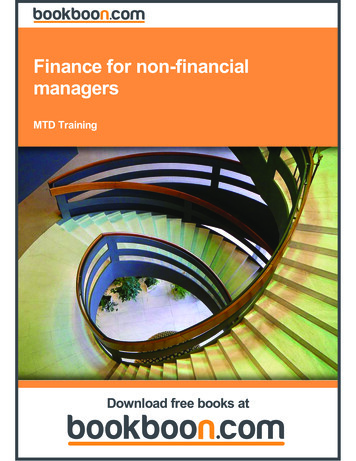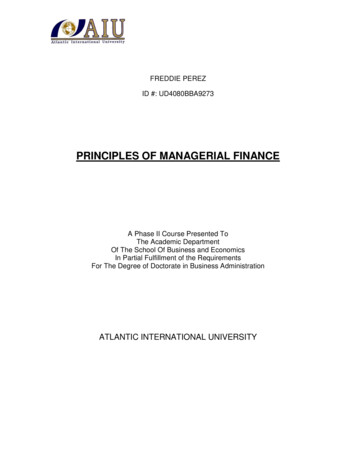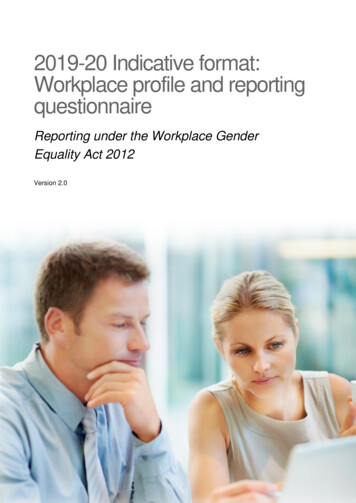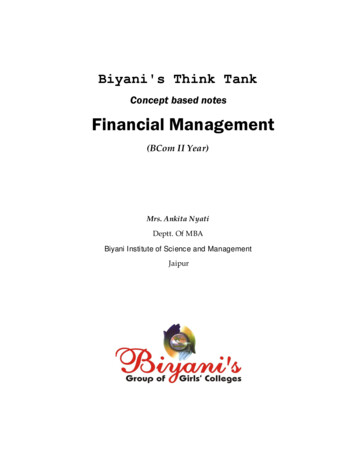
Transcription
Finance for non-financialmanagersMTD TrainingDownload free books at
MTD TrainingFinance for Non-financial ManagersDownload free eBooks at bookboon.com2
Finance for Non-financial Managers1st edition 2010 MTD Training & bookboon.comISBN 978-87-7681-722-0Download free eBooks at bookboon.com3
Finance for Non-financial nderstanding Finance Basics91.2Three Basic Finance Principles91.3Basic Finance Terms111.4Overview of the Ebook112Financial Information Every Organization Needs132.1Introduction132.2Bookkeping (Accounting)2.3Chart of Accounts2.4The General Journal (Original Book of Entry)2.5The General Ledger360 thinking.360 thinking.13141617360 thinking.Discover the truth at www.deloitte.ca/careers Deloitte & Touche LLP and affiliated entities.Discover the truth at www.deloitte.ca/careers Deloitte & Touche LLP and affiliated entities.Download free eBooks at bookboon.com Deloitte & Touche LLP and affiliated entities.Discover the truth4 at www.deloitte.ca/careersClick on the ad to read more Deloitte & Touche LLP and affiliated entities.3tDiscov
Finance for Non-financial ManagersContents3Balance Sheet203.1Introduction203.2What a Balance Sheet Tells You203.3What the Balance Sheet Doesn’t Tell You224The Income Statement234.1Introduction234.2Elements of the Income Statement234.3What an Income Statement Tells You264.4What an Income Statement Does Not Tell You275Cash Flow Statement285.1IntroductionTMP PRODUCTIONNY026057B42812/13/20135.2Cash Flow Categories5.3Preparing the Cash Flow Statement6Understanding Budgets326.1Introduction326.2Approaches to Budgeting336.3Reading the oon Ad CreativeAll rights reserved. 2013 Accenture.Bring your talent and passion to aglobal organization at the forefront ofbusiness, technology and innovation.Discover how great you can be.Visit accenture.com/bookboonDownload free eBooks at bookboon.com5Click on the ad to read more
Finance for Non-financial ManagersContents7Pricing367.1Introduction367.2How Important is Price?367.3Demand for the Product or Service367.4Your Environment367.5Pricing Strategies378Applying Your Knowledge398.1Introduction398.2Defining Your Reasons398.3Background408.4Objectives408.5Scope of Operations418.6Operational Constraints428.7Understanding Risk459References48.Download free eBooks at bookboon.com6Click on the ad to read more
Finance for Non-financial ManagersPrefacePrefaceToday’s managers need to be more commercially aware more so than ever before. Even if they do nothave to manage budgets or finances themselves as part of their role they still need to understand aboutthe financials of a company, what it all means and the impact of their actions on the bottom line.In this textbook you’ll receive a thorough grounding that explains what all of the financial statementsof a company means from a “non finance” point of view. Explained in easy to understand language, youwill soon gain a great insight into the finance aspects of a company even if you have no direct inputinto the financials yourself.Sean McPheat, the Founder and Managing Director of management development specialists, MTDTraining is the author of this publication. Sean has been featured on CNN, BBC, ITV, on numerousradio stations and has contributed to many newspapers. He’s been featured in over 250 differentpublications as a thought leader within the management development and training industry.MTD has been working with a wide variety of clients (both large and small) in the UK and internationallyfor several years.MTD specialise in providing:In-house, tailor made management training courses (1–5 days duration)Open courses (Delivered throughout the UK at various locations)Management & leadership development programmes (From 5 days to 2 years)Corporate and executive coaching (With senior or middle managers)MTD provide a wide range of management training courses and programmes that enable new andexperienced managers to maximise their potential by gaining or refining their management andleadership skills.Download free eBooks at bookboon.com7
Finance for Non-financial ManagersPrefaceContact ukTelephone:From The UK: 0800 849 6732International: 44 2476 233 151Download free eBooks at bookboon.com8
Finance for Non-financial ManagersIntroduction1 Introduction1.1Understanding Finance BasicsPeople can spend a lifetime studying the principles of finance in the business world. The financial situationof an organization is impacted by every decision made and every action taken. In fact, you could arguethat everything a business every does is actually somehow a financial activity. For example, you lose acustomer and it impacts revenue. You spend money on a marketing campaign that has a huge returnand you’ve made a positive financial investment. If you don’t keep your team members on task, you’reeffectively wasting company resources.You could argue that everything a business does is actually somehow afinancial activity.Non-financial managers in an organization can still benefit from understanding finance because theywill then be aware of how their decisions impact the overall financial health of the organization. Theycan become more conscientious about their decision making and their operations in order to help theorganization’s bottom line. If you are a small business or an independent entrepreneur, understandingthe basic principles of finance could mean the difference between your business surviving and thrivingor failing. You need to understand how to read a budget, create a budget, and to invest your resourcesto get the maximum benefit that you can.1.2Three Basic Finance PrinciplesIf you want to be financially aware, even as a non-finance manager, you have to be able to look at youractions and the actions of your team in terms of basic financial principles. You don’t have to assign adollar value to every activity, but you should think in large terms about how your decisions will impactthe financial well-being of the business.Remember too that there are both direct and indirect impacts on the organization’s finances. Forexample, you might deny a customer a credit on their bill that they feel they deserve because you aresaving money for the organization. But if that customer leaves your organization for the competition,you have indirectly impacted the company’s finances in a negative manner because you have lost thefuture revenue that the customer would have provided.You don’t have to assign a dollar value to every activity you undertake, but youshould think in large terms about how your decisions will impact the financialwell-being of the business.Download free eBooks at bookboon.com9
Finance for Non-financial ManagersIntroductionThere are three basic principles that form the framework for all corporate finance:The Investment PrincipleEvery business invests assets and incurs debts of some sort, even if the debt is in the form ofequity owned by the owner or a partner.The Financing PrincipleBusinesses can finance their operations with a mixture of tools that include investments inassets or borrowing money such as through loans or bonds. Or, they could sell stock if they arepublicly traded. This mixture can depend on several things such as legal issues, the business’willingness to take on risk, and the capital available versus the capital needed.The Dividend PrincipleA successful business will eventually need to return some money to its investors. This could bethe owner taking some cash out of the till or it could be in the form of stock dividends. Again,it depends on many characteristics of the business such as legal form and requirements, size,and what those receiving the dividends prefer.In essence, the way an organization manages its finances is guided by these three principles. However,the way in which the principles are applied will vary greatly from organization to organization.The Wakethe only emission we want to leave behind!"# %&''()* ,- '%))).'(-/0 %&''()* ,- '%)))1/23"4562,'2%)))72"&'88'2%)))72"&/8%-" )76496,'%)))72-0':'2;!"# %#&'() * #,*- .'#)%/0 12.')# 3*4#. 2)% 3.*35/&'*) &*/56'*)& '& ,.5,'2/ *. 789 :'#&#/ ; !5. * *4#. ,*13#6#),'#& 2.# * #.#% 4'6" 6"# 4*./%?& /2.(#&6 #)(')# 3.*(.211# @ "2A')( *56356& &32))')( .*1 BCD 6* EFGHHD IJ 3#. #)(')# K#6 53 .*)6LM')% *56 1*.# 26 444 12)%'#&#/65. * ,*1Download free eBooks at bookboon.com10Click on the ad to read more
Finance for Non-financial Managers1.3IntroductionBasic Finance TermsFinance has its own “lingo.” In order to help you understand what is explained in the rest of the ebook,you should have some basic terms under your belt. Figure 1 lists some of the most commonly usedterms in corporate finance.AssetsItems owned by the business (see Capital Assets, Current Assets and Fixed Assets)BondsCertificates of debt which are issued by an organization in order to raise funding. Thebond holder earns a fixed rate of interest (usually) and the bond must be repaid by aspecific date.CapitalAssets available to be invested with the intention of creating new assets.Capital AssetsTangible property that is not easily converted into cash. Capital assets are usually heldlong-term and include things like buildings, equipment, and other owned items.Capital BudgetThe plan a company has to finance existing or new capital assets. Organizations usuallyhave a capital budget and an operating budget. (See operating budget).Current AssetsThe company’s total of cash, accounts receivable, and other assets that could beconverted into cash within a year. This is the money usually used for day-to-dayoperations.Debt FinancingCreating capital by incurring debt such as by selling bonds or notes.Equity1) The total of a company’s assets minus its liabilities2) Ownership interest in a corporation in the form of stockExpensesAny cost of operating the businessFixed AssetsLong-term, tangible assets that are used by the business tnd that the organization doesnot plan to convert to cash in the current or next fiscal year.LiabilitiesA financial obligation such as debts, claims, or lossesOperating BudgetA projection of estimated income and expenses during a specific period. An operatingbudget is short-term, usually for one year, while a capital budget is long-term.RevenueIncome generated as part of the operations of the organization before liabilities aresubtracted.Figure 1: Basic Finance Terms1.4Overview of the Ebook1.4.1Financial Information Every Organization NeedsWe’ll start the conversation about finance by looking at the kind of information that every organizationhas to keep track of regarding their financial transactions. We’ll discuss:The importance of the three main financial reports:The Balance SheetThe Income StatementThe Cash Flow StatementDownload free eBooks at bookboon.com11
Finance for Non-financial ManagersIntroductionThe main tools of bookkeeping, including:What a Chart of Accounts is, how it is organized, and why it mattersThe General JournalThe General Ledger1.4.2The Balance SheetIn the next chapter, we’ll take a closer look at the Balance Sheet. We’ll examine:How one is createdWhat information it includesWhat it tells youWhat it doesn’t tell you1.4.3The Income Statement, The Cash Flow StatementIn the following two chapters, we’ll look at the same information for the Income Statement and the CashFlow Statement as we did for the Balance Sheet. By the end of this discussion, you should understandthe difference between the statements as well as how they are related.1.4.4Understanding BudgetsIn this chapter, we’ll look at budgets as more than just a document that describes the way that revenue willbe allocated and spent by the different departments. It’s also a policy document that states the organization’spriorities and demonstrates how the organization plans to use its resources to accomplish them.1.4.5PricingDetermining how to set prices is one of the most challenging and important decisions that an organizationcan make. We’ll look at how prices are set and what elements should be considered when determininghow to position an organization’s products and services from a price point of view.1.4.6Applying Your KnowledgeThis final chapter will take the theoretical information you’ve learned in the previous chapters andwill discuss ways that any manager can apply the knowledge in their decision making and day to dayoperations.Download free eBooks at bookboon.com12
Finance for Non-financial ManagersFinancial Information Every Organization Needs2 Financial Information EveryOrganization Needs2.1IntroductionSince the goal of all businesses is to maximize profits, the management team needs information to helpthem navigate financial decisions. All businesses produce financial statements that provide differentinformation about the organization’s financial health. That information is used by the senior managersto make important decisions regarding the organization’s future. The three main financial statementsthat are produced are:The Balance Sheet (also called a Statement of Financial Condition or Statement of FinancialPosition)The Income Statement (also called a Profit and Loss Statement, Statement of Operations, orStatement of Earnings)The Cash Flow StatementIf you are a manager, you will want to be familiar with these documents so that you can read and interpretthe information. Then you can apply that information to operating your own division or department. Inthe following chapters, we’ll look at each of these statements individually to understand:How the statement is createdHow to read the statementWhat the statement tells you, and just as importantly –What the statement does not tell youHowever, none of these financial statements can be created without information from your organization’saccounting or bookkeeping information.2.2Bookkeping (Accounting)Bookkeeping is the act of keeping up with the changes in an organization’s accounts. Every time yourorganization performs a transaction of any kind, the accounts (books) change. For example, if you operatea retail establishment and you make a sale, the inventory of that item or items decreases and the amountof your cash increases. Various ledgers and journals are used to track these changes. Those ledgers andjournals are then used to create the financial statements listed above.Accounting has one very fundamental equation:Total Assets Total Liabilities EquityDownload free eBooks at bookboon.com13
Finance for Non-financial ManagersFinancial Information Every Organization NeedsIn other words, what the company has in value is the difference between what they own and what theyowe. It works the same for you as an individual. Your net worth is the total of your assets minus anydebt that you owe. For a business, there are usually just more assets and liabilities to calculate.To see this more easily, just rewrite the equation as:Equity Total Assets – Total LiabilitiesIn either version of the equation, what will happen when a transaction occurs? At least two of thefactors will change for any transaction. So, for example, if your equity increases, your assets must haveincreased or your liabilities must have decreased – or both. Accounting is the process of tracking allof these changes in the financial equation. The accountant or bookkeeper must then be able to recordthe information and report the information in ways that are helpful for those that are making decisionsabout the operations and direction of the organization.2.3Chart of AccountsThe tool used to track the changes described above is the Chart of Accounts. A business has specificaccounts within their chart which correspond to the assets and liabilities that the organization has. Forexample, some accounts in the chart of accounts for a temporary agency might be:Assets:- Cash- Accounts Receivable- EquipmentLiabilities:- Salaries- Benefits- Advertising- Accounts PayableHowever, there are usually dozens – if not hundreds – of accounts under both assets and liabilities.It depends on how the organization tracks all of their finances. For example, if you work for a largecorporation with multiple departments, you will have more accounts in your Chart of Accounts than ifyou are a one-man consulting firm.Download free eBooks at bookboon.com14
Finance for Non-financial ManagersFinancial Information Every Organization NeedsIn conventional accounting, all of the accounts the company uses are grouped together by like categoriesand then are numbered according to a standard format. The conventional numbering system is:Assets 101–199Liabilities 200–299Equity 300–399Revenue 400–499Expenses 500–599Some organizations might use 600s for expenses. And an organization can also add account identifiersto further subdivide an account. For example, you could have an expense account 501 for “utilities” andadd identifiers for each utility so that it might look like this:501001 – Gas501002 – Power501003 – Water501004 – Waste DisposalDownload free eBooks at bookboon.com15Click on the ad to read more
Finance for Non-financial ManagersFinancial Information Every Organization NeedsOr, an organization with multiple departments that also budgets and tracks expenses by departmentscould use sub-identifiers to denote an expense for each department. So, for example, perhaps all utilitiesfor the organization start with a 501, then all the Marketing department utility expenses add a subidentifier of 001, followed by another sub-identifier to denote the actual expense. So, let’s imagine you’relooking at all the charges for waste disposal across multiple locations. It could look like this:Marketing: 501004-001IT: 501004-002Training: 501004-003Another way of dividing the chart of accounts is to have the first part of the account number identifythe source of the fund that is used to pay for the expense or the destination fund of where the revenuewill be going. You see this when an organization has regulations that limit or define how revenue needsto be used. For example, if your organization has received a government grant, you may have to usethat grant only for specific activities. You can use your chart of accounts to help you track the expensesyou use that grant money for, which will make your life easier if you have to demonstrate your use ofthe grant funds.2.4The General Journal (Original Book of Entry)The General Journal is used to record transactions that occur. Today, this is usually done electronicallywith financial software, but of course it used to be done in a large written journal. In order to recordtransactions correctly, you need to know the rules accountants used called “transaction analysis.” Thetwo rules are:Asset and Expense accounts increase with a debit and decrease with a credit.Liability, Equity, and Revenue accounts increase with a credit and decrease with a debit.Imagine that you purchase a computer with 600 in cash and 1200 store credit. An example of a GeneralJournal entry for this transaction is shown in Figure 2.Notice that the purchase of one item required an entry for three different accounts. You can see thename of each account under “description” and the number of the account under column ‘F’. The GeneralJournal is kept in chronological order, which can be very helpful if you need to look back over the historyof your transactions.However, there is one glaring piece of information that is missing on the General Journal. You don’tsee any information about the balance in each account that you have impacted. For example, just bylooking at the General Journal, you don’t have any idea how much cash you have left after the purchaseof the computer. To track the changes in account balances, your accounting team uses a General Ledger.Download free eBooks at bookboon.com16
Finance for Non-financial ManagersFinancial Information Every Organization NeedsGENERAL JOURNALFY20XXNov22PAGE 0Accounts Payable2001,200Purchase of Computer with 600 cashand 1200 store creditFigure 2: Example of General Journal Entry2.5The General LedgerThe General Ledger is organized by ledger accounts. There is one ledger account for each account inyour Chart of Accounts. The accountant will take the information from the General Journal and postit to each of the General Ledger accounts that were affected by the transaction. Again, this is normallydone electronically today, with software that automatically posts to the ledger accounts each time youenter a transaction in the General Journal. But just to be sure you understand how the information isposted, let’s look at an example of how we would post to the ledger accounts from the General Journalentry in our example from Figure 2 again.GENERAL JOURNALFY20XXNov22PAGE nts Payable2001,200Purchase of Computer with 600 cashand 1200 store creditYou’re going to want to post to three accounts:Equipment (144)Cash (101)Accounts Payable (200)Download free eBooks at bookboon.com17Credit
Finance for Non-financial ManagersFinancial Information Every Organization NeedsFigure 3 shows the three entries you would make in the General Ledger.GENERAL LEDGEREquipment Account 4,200ComputerJ21,800FDebit6,000GENERAL LEDGERCash Account omputerJ26003,100CreditBalanceGENERAL LEDGERAccounts Payable Account Figure 3: Examples of General Ledger Account EntriesDownload free eBooks at bookboon.com181,8002,600
Finance for Non-financial ManagersFinancial Information Every Organization NeedsTo read the entries, here is an interpretation of the information:The first entry in each ledger shows the balance from the previous monthIn Colum F, the reference is to the page in the General Journal (J for Journal, 2 for the pagenumber) where the item was recorded.Now that the information is posted, the financial statements that need the information can be prepared.Join our sales team! We are a dynamic global business experiencing rapid growthAre you looking for a new challenging position that requires self-motivation and allows you to work independently?Bookboon is the world’s largest eBook publisher with a very strong presence in USA.Established in 1988, Bookboon is currently operating in more than 30 countries.We have an impressive client base of over 100 major accounts. Bookboon is looking for dedicated sales people inUSA to be part of our ongoing success.As a part of our worldwide sales team, you will be rewarded with a competitive sales and target structure anduncapped earning potential. We are looking for sales people with experience in selling solutions towards CEOs,HR, Marketing or sales departments.Please send your CV to jobs@bookboon.comApply Now!Download free eBooks at bookboon.com19
Finance for Non-financial ManagersBalance Sheet3 Balance Sheet3.1IntroductionNow you’ve seen how the day-to-day recording of transactional information is recorded. But how do youput it into a format that can help you see the financial state of the organization? This is where the BalanceSheet comes in. It is a ‘snapshot’ of the finances of the business at one given time. The information givenincludes what the business owns and what it owes.There are three sections to the Balance Sheet:Assets – the items of value owned by the companyLiabilities – the company’s obligations, whether to pay for or provide goods or services at afuture dateEquity – remembering our equation from Chapter 2, equity is the amount of net assets(assets – liabilities)A Balance Sheet gets its name from the fact that the total of the assets listed must equal the total ofthe liabilities and equity – in other words, the two sides of the sheet must balance. For an example of aBalance Sheet, see Figure 4. It’s a relatively simple example, since most businesses will have many moreaccounts under their assets, liabilities, and equity categories on their Chart of Accounts. But you can getthe basic idea for how the information is shared via the Balance Sheet.3.2What a Balance Sheet Tells YouThere is good information on the Balance Sheet, such as:A summary of the organization’s assets and the claims against those assets as of a specificdate.Information about the organization’s current ability to pay its current debts. You can onlytell at the moment, for the liabilities that the accounting team has already entered into thefinancial system. If a large liability were to be incurred tomorrow, the financial picture couldshift significantly.The information shows how the organization is positioned to keep going with the day today business operations. For example, the assets listed give you some idea of what you haveavailable right now to keep trying to generate new assets (new revenue).The Balance Sheet also shows what claim the owners have against the business’ assets. Ofcourse, this is conditional on the other liabilities being satisfied.Download free eBooks at bookboon.com20
Finance for Non-financial ManagersBalance SheetABC EnterprisesBalance SheetAs of November 30, 20XXAssetsLiabilitiesCash8,500Bank Loan5,000Inventory14,000Accounts Payable1,200Accounts Receivable2,200Total LiabilitiesEquipment4,6006,200EquityTotal Assets29,300Paid in Capital15,000Retained Earnings8,100Total Equity23,100Total Liabilities &Equity29,300Figure 4: Sample Balance SheetDownload free eBooks at bookboon.com21
Finance for Non-financial Managers3.3Balance SheetWhat the Balance Sheet Doesn’t Tell YouOf course, there are several parts of the financial picture that are not included in the Balance Sheet. Forexample, the Balance Sheet does not tell you:How any profits were made. For that information, you’d need to look at the IncomeStatement.Which assets creditors have claims against. For example, if you are financing equipment,your creditor has a claim against that equipment until it is paid.What kind of capital investment was made. You might assume that we’re talking about cash,but instead, the owner or owners might have purchased a building that is not necessarilyconvertible back to cash (at least not immediately).What value the business would have on the market place. For example, if the ownerpurchased that building for 50,000 10 years ago, it might be worth twice that now. Or, itcould even be worth less if the real estate market has suffered since then.Brain powerBy 2020, wind could provide one-tenth of our planet’selectricity needs. Already today, SKF’s innovative knowhow is crucial to running a large proportion of theworld’s wind turbines.Up to 25 % of the generating costs relate to maintenance. These can be reduced dramatically thanks to oursystems for on-line condition monitoring and automaticlubrication. We help make it more economical to createcleaner, cheaper energy out of thin air.By sharing our experience, expertise, and creativity,industries can boost performance beyond expectations.Therefore we need the best employees who canmeet this challenge!The Power of Knowledge EngineeringPlug into The Power of Knowledge Engineering.Visit us at www.skf.com/knowledgeDownload free eBooks at bookboon.com22Click on the ad to read more
Finance for Non-financial ManagersThe Income Statement4 The Income Statement4.1IntroductionDuring the fiscal year, any organization will have changes in its finances. The changes could be positiveor they could be negative. But the senior management of an organization will want to know the answersto questions like:How well are we doing financially?Are we earning a profit?Are we running at a loss?How is our profit in comparison to the competition?Are we likely to continue earning profit?To answer these and similar questions, you can use an Income Statement.4.2Elements of the Income StatementWhereas the Balance Sheet offers a snapshot of an organization’s finances at one given point in time,the Income Statement looks at incoming revenue and outgoing expenses over a period of time. For theIncome Statement we use the following definitions:Revenue – incoming assets in return for sold goods or services (cash or accounts receivable,for example).Expenses – outgoing assets or liabilities incurred (accounts payable, inventory sold orsupplies used, for example).Net Income – the difference between Revenue and Expenses.With all of this information, the Balance Sheet shows you whether you are generating a profit or youare operating at a loss. For an example of a Balance Sheet, see Figure 5.Download free eBooks at bookboon.com23
Finance for Non-financial ManagersThe Income StatementWidget Works, Inc.Income StatementFor the Month Ended February 28, 20XXRevenueSales Revenue9,700Consulting Revenue2,000Investment 5Total Expenses8875Net Income 3,375Figure 5: The Income StatementThe bottom figure on the chart in Figure 5 is the Net Income. This is the difference between theorganization’s assets and its liabilities. It is the amount by which the equity of the organization increasesor decreases in a given period. This amount would also be recorded in an equity account, also called aRetained Earnings account, depending on the type of organization yours is. This takes us back to theBalance Sheet. Remember the sample Balance Sheet created for ABC Enterprises in the last chapter?Here it is again. Notice where the Retained Earnings amount is listed.Download free eBooks at bookboon.com24
Finance for Non-financial ManagersThe Income StatementABC EnterprisesBalance SheetAs of November 30, 20XXAssetsLiabilitiesCash8,500Bank Loan5,000Inventory14,000Accounts Payable1,200Accounts Receivable2,200Total LiabilitiesEquipment4,6006,200EquityTotal Assets29,300Paid in Capital15,000Retained Earnings8,100Total Equity23,100Total L
In this textbook you’ll receive a thorough grounding that explains what all of the "nancial statements . Sean McPheat, the Founder and Managing Director of management development specialists, MTD Training is the author of this publication. Sean has been featured on CNN, BBC, ITV, on numerous .











